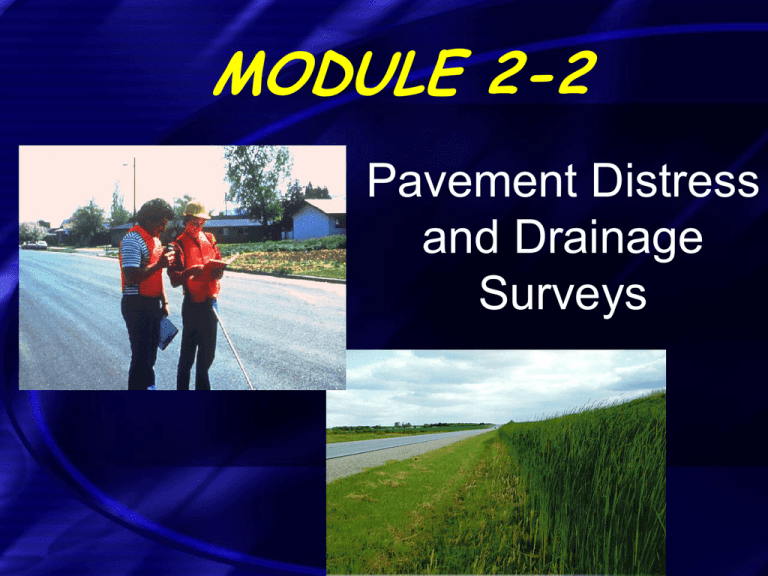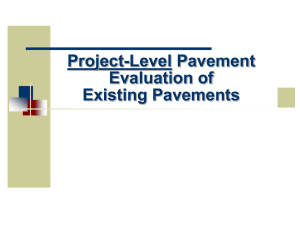HMA Module 02
advertisement

MODULE 2-2 Pavement Distress and Drainage Surveys Learning Objectives • Describe the reasons for conducting pavement distress and drainage surveys • List the 3 factors needed to characterize pavement distress • Identify the various HMA distresses and their probable causes • Describe the key components of a manual distress survey and a drainage survey • Describe ways of analyzing and presenting distress survey results Purposes of Distress Survey • • • • • • • Document pavement condition Identify types of distress Group areas of similar performance Gain insight into causes of deterioration Identify additional testing needs Identify possible rehabilitation treatments Identify repair areas and quantities First step in pavement evaluation process Purposes of Drainage Survey • Identify moisture-related distress • Document drainage conditions of pavement • Assess condition and effectiveness of edge drains (if present) Project-Level vs. NetworkLevel Surveys • Project-level surveys – Specific projects – Identify deficiencies – Identify appropriate rehabilitation • Network-level surveys – Selected sections or samples – Identify projects for rehab – Planning and allocation of funding Pavement Distress • Fundamental performance indicator • Characterized by: – Type What? – Severity How Bad? – Extent How Much? Distress Identification Manual • Standardized distress definitions • Benefits – More consistent calls – Better communication within and between highway agencies – Improvements in any agency activity using pavement performance information • Degree of sophistication – Project-Level – Network-Level LTPP Distress Identification Manual • Research-oriented • All pavement types • Distress definitions – Description – Severity levels – How to measure • Schematic drawings • Photographs • Data collection forms Common HMA Distresses Distress Type Traffic/ Load Fatigue Cracking Block Cracking Trans/Long Cracking Potholes Patch/Patch Deter. Rutting/Shoving Bleeding Weathering/Raveling X X X X X Climate/ Materials X X X X Fatigue Cracking Fatigue Cracking Fatigue Cracking Potholes Transverse Cracking Transverse Cracking Transverse Cracking Transverse Cracking Transverse Cracking Block Cracking Rutting Raveling Bleeding Pavement Distress Surveys • Manual (project-level) – Walking over pavement – Pavement distresses recorded • Automated (network-level) – Pavement surface videotaped by specialized vehicle at highway speeds – Distress later interpreted in office off of videotapes – Commonly done for PMS – Will trigger potential rehab projects Manual Distress Surveys • For project-level evaluation, manual procedures often preferred • Components: – Pre-survey activities – Initial windshield survey – Detailed distress survey – Photographs/videotapes – Drainage survey Pre-Survey Activities • • • • • Project design and location data Data collection forms Distress identification manual Information from previous surveys Traffic control arrangements Windshield Survey • Assess uniformity of distress over project limits • Assess overall rideability • Identify sampling/testing locations Walking Survey • Two-person crew • Record and map all pavement distress • May need traffic control on busy roadways SHRP Distress Form Photographs/Videos • Document condition • Capture typical distresses • Communicate pavement condition to others Hand-Held Computer • Enter distress data directly • Data downloaded later to PC • Reduces data processing time • Eliminates transcription errors Drainage Surveys • Conducted as part of manual surveys • Goal is to determine if excess moisture is affecting the performance of the pavement Components of Drainage Surveys • • • • • • Topography and cut/fill Pavement and shoulder slopes Condition of ditches Geometrics of ditches Condition of drainage outlets or inlets Effectiveness of edge drains Topography and Condition of Ditch Condition of Outlets Video Inspection Evaluation of Distress Survey Results • Summarize distress data for project – Cracking – Rutting • Prepare strip charts – Observe performance over project – Evaluate with other collected data • Prepare historical performance charts Fatigue Cracking Strip Chart Silty Clay High Traffic Granular Silty Clay Low Traffic Condition 1 Condition 2 Condition 3 FC (%) Severity Low Medium High Distance Along Project Fatigue Cracking, % Area Performance Trends Section 1 Section 2 Section 3 1985 1990 1995 Year 2000 Drainage Evaluation • Presence of moisture-related distresses • Condition of ditches and outlets • Evaluation of drainage times – Time that pavement is saturated – Less than 10 hours to 85% saturation is desired – Manual calculations or DRIP computer program Review • What are the purposes of conducting pavement distress and drainage surveys? • What three factors are needed to characterize pavement distress? • What are some of the key components of a manual distress survey and a drainage survey? Key References • Strategic Highway Research Program (SHRP). 1993. Distress Identification Manual for the Long-Term Pavement Performance Project. SHRP-P-338. Strategic Highway Research Program, Washington, DC. • Gramling, W. L. 1994. Current Practices in Determining Pavement Condition. NCHRP Synthesis of Highway Practice 203. Transportation Research Board, Washington, DC.







